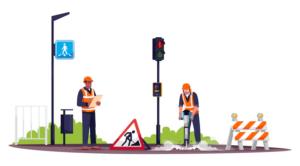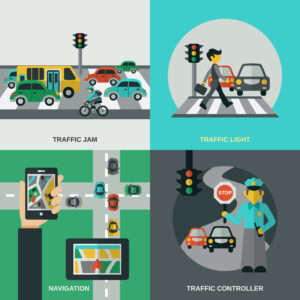Traffic Impact Study or Traffic Impact Analysis or Traffic Impact Assessment is an evaluation conducted to identify the likely impacts a new development is going to have on the available transportation system. It shows how the extra generated traffic from the development is going to impact road capacity, traffic flow, and safety.

Traffic Impact Study is an important tool in assessing the impacts of new developments on existing transportation networks. New projects put additional loads on the roadways as an urban area continues to grow, which may cause congestion, safety issues, and a decline in the quality of life of its citizens. Traffic Impact Studies & Analysis allows for projection of these potential problems and the ability to take mitigating measures by analyzing current traffic conditions against future denoted impacts. These studies assure that new developments, especially in areas of congestion or near critical corridors, fit properly into the transportation network by identifying necessary infrastructure improvements and safety measures.

TIS and TIA are essential urban planning tools that provide data-driven insight for development decisions. Therefore, whenever there is a new development proposal, most local governments will usually require a traffic impact study or traffic impact analysis in order to project any future traffic problems that might occur after the completion of the development .
What is important is their balancing of the interest of developers with that of the community. For example, a new shopping mall or residential complex may usher in economic gains and convenience but add to evils like increased traffic, noise pollution, and concerns to human safety. All these impacts are carefully estimated through a TIS or TIA to let the decision-makers weigh the pros against the cons so that developments are awarded approval, modified, or rejected with full knowledge of the effects.
In addition, it provides a basis for TIS and TIA in infrastructure investment planning. If high traffic impacts are identified through a study, works such as the construction of new roads, upgrading intersections, or even the enhancement of public transport have to be done in time for long-term avoidance of future traffic problems and for the transportation network to be prepared to bear any expected growth.

During the process of development, for any major development, either it is a hospital or shopping center, or large residential complex, a TIS will have prime importance at the planning and approval stages. For any new hospital under development, it would cause an impact on existing transportation networks. The government imposes TIA, for the most part, in the form of a Traffic Impact Study, so as not to bring an adverse effect on the traffic flow, road safety, and general infrastructures. Either the government can provide the list of accredited consultants qualified to perform such studies or the list can be provided by the developer. This study helps the decision-makers forecast what the potential traffic implications might be and whether the increased traffic can be supported by the existing infrastructure.
A Traffic Impact Study begins with specifying the project scope, indicating which facets of traffic, study will examine. The following step involves data collection, where existing traffic conditions will gather in terms of volumes, speeds and accidents. After that, Study will make trip generation in order to determine that hospital will have how many additional vehicle trips especially at peak hours. Subsequently, this investigation continues with an examination of intersection capacity ascertaining whether the old junctions can accommodate additional movement. If necessary, it suggests proper remedial measures like widening roads or readjusting signals timing or enhancing turning lanes within the vicinity.
In conclusion, all reports findings analyses and recommendations compile together in a comprehensive report and sent to the relevant governmental department for scrutiny and approval.
The implementation of a Traffic Impact Study uses many tools. For example, simulation software usually exists in the form of Synchro or VISSIM models for traffic flow and performance at intersections under a variety of conditions. Perhaps the most important source document relating to the determination of the number of trips generated by the development is the Institute of Transportation Engineers source document which we call it a Trip Generation Manual. GIS can also enable one to map and analyze the spatial dimension of the data on traffic. Such tools, coupled with the capacity for the traffic engineers to use them, will mean that the Traffic Impact Study is comprehensive and accurate, grounded on quality information that allows proper planning and decision-making.

Normally, a traffic impact study or any traffic impact analysis is carried out by professional practicing traffic engineers certified to be PTOE—Professional Traffic Operations Engineers. Professionals or experts from this field use advanced software in predicting how new development will impact the local road network regarding traffic flow, intersection performance, and pedestrian safety.
They deal with the knowledge of traffic patterns, road design, and vehicle behaviors. They worked in conjunction with urban planners, civil engineers, and local government representatives to ensure that all factors of the transportation network are addressed on road capacity, traffic light signals, pedestrian access, and mass transit.
A TIS—Traffic Impact Study—determines the impact that development will have on traffic by looking at how new land uses will impact the transportation system.
TIS and TIA bear huge importance for the development in the process of gaining approval. The local government uses these studies to decide whether a project needs approval, mitigation, or rejection due to the potential impact of traffic. Redesigning of the projects or developing new mitigation measures if the TIA identifies significant problems with the flow of traffic.
These could include road widening, installation of traffic signals, turn lanes, or intersection reconstruction to guide the flow of traffic safely. It is mandatory for developers to make these changes as a condition of approval for their projects, thus doing their share to reduce the traffic impact of their development on the community.
Traffic Impact Study or Traffic Impact Analysis are the two most fundamental tools in the hands of an urban planner and a developer. They provide details regarding how new developments would impact the transportation network, hence ensuring growth that is sustainable, safe, and in the best interest of the community. This requirement, due to urban sprawling, is continuously increasing and shall increase manifold in times to come, becoming an integral part of responsible development planning.
For Further Details Contact Us Now!